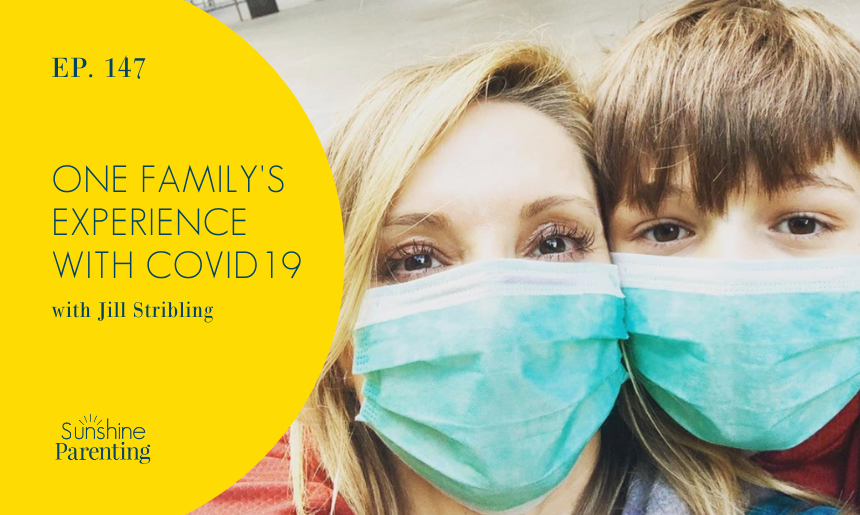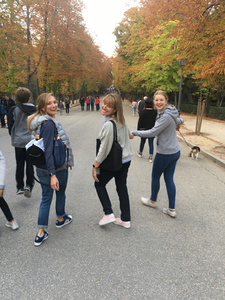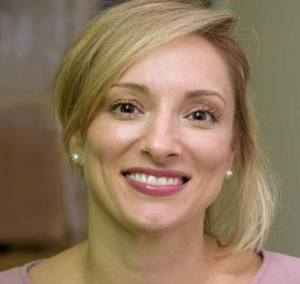
This week I’m talking with my friend Jill Stribling. Jill’s family has first-hand experience with COVID-19. If you’re a longtime listener, you may remember my chat with Jill back in Ep. 35 about her decision to unplug her family, including her 10-year-old son, whose behavior around screens had started to concern her.
About Jill
Jill is a teacher and is the owner and founder of English for Fun, a school in Madrid, Spain. English for Fun is a learning laboratory where children and adults are empowered to take risks and try new things. They collaborate with the best research institutes throughout the world in order to bring quality education to Spain and to the world.

Jill, Audrey, & Audrey’s daughter Meredith in Madrid (October, 2017)
Jill Stribling has a B.A. in Child Development and Psychology and a Master’s degree in Education and specialty in Literacy and Language Arts from California State University and more than 20 years of experience in education. After several years teaching in public schools in Los Angeles, CA, she was recruited by the American School of Madrid in 2001, where she taught Kindergaten and First Grade and took on several leadership roles (i.e. Grade Level Chair, Accreditation Committee Leader, etc.). With her educational and professional experience firmly in place, she developed a methodology for making language learning fun, and began her entrepreneurial journey in 2008 with literally one student in her living room. Shortly afterwards, she had a total of

Jill Stribling
70 students, and actually had to expand her business. English for Fun is an educational group with an English Enrichment Program for children and adults, an Urban Camp Program, an American Early Childhood Center and a Training Center for educators. Today, she owns schools in Madrid and Pozuelo de Alarcon, and this year alone more than 3,000 students will benefit from the English for Fun method!
Back in the fall of 2018, I had the privilege of visiting the Stribling family, touring English for Fun, and speaking with the parents at both of the school campuses.
Big Ideas
It is important to think of others during this time.
If we are not careful, we could cause the death of someone that we or someone else loves.
This is a great time to stay inside and work on ourselves.
Quotes
Jill: I think that this was the scariest thing that I’ve ever been through in my entire life.
Jill: We were really lucky that he recovered in a week.
Jill: I think that now looking back on it, we realize, you know, how crazy everything was and how fortunate we are. But, um, but yeah, it was not easy. And, and, you know, I wish looking back on everything that, that not only would we have taken this more seriously when it happened.

Jill: If you are someone who is a carrier and you infect other people, you will never know if you caused a death for somebody that someone else loves.
Audrey: It’s almost as if like, if you don’t know anyone directly, it must not be that serious or something. And these numbers of deaths on that we see on the news just seem not as relevant if you don’t know them, which is sad.
Jill: The thing about how contagious it is is that you don’t even realize it until it’s too late.

Jill: So that for me is the hardest part of this, is all the damage you do to others when you’re not careful.
Jill: By the time you realize that you have it, you’ve already passed it to eight to fifteen people.
Audrey: I was wishing we had done better because now of course we’re seeing that it’s kind of everywhere now and cases are still going up in like most of our states.

Jill: I think COVID is kind of teaching us that, you know, we’ve gotta live differently.
Jill: It’s not about me anymore. It’s about somebody’s grandmother. It’s about somebody’s mother who could have cancer. And I know that for a fact, because I have seen it.
Jill: I get it like we’re social. We want to go out. But I think right now it’s the time to work on ourselves.

Audrey: I, like you, hope that from this, we learn that we are a community. We’re a global community. What happens over there impacts us, we all have a responsibility.
Resources/Links
NY Times article Jill mentions
I’m Still Here: Black Dignity in a World Made for Whiteness Review by Audrey
One Simple Thing – Find Your Flow
What is “Flow”?
Flow is a term coined by psychologist Mihaly Csikzentmihalyi (pronounced “cheeks sent me high”) that refers to a state of optimal experience and involvement in an activity during which we are performing at our best.
Watch Dr. Csikszentmihalyi talk about flow in his TED Talk, “Flow, the Secret to Happiness.”
When we’re in “flow,” we are doing something we really, really enjoy. We can’t wait to do the activity again, and we feel a lot of positive emotions while participating in the activity. We can stick with it for hours without even noticing the time going by. In fact, when we’re in flow, it’s hard to stop whatever we’re doing. Flow is different from pleasure – simply doing things that are enjoyable like watching TV, scrolling on social media, or shopping. Instead, flow activities usually are demanding and take our full attention and concentration.
How do I achieve flow?
People achieve flow in all different ways, including while playing a musical instrument, playing a sport, writing, painting, attending a concert, bird watching, riding a horse, or running, to name just a few. Often we cannot relate to the passion others have for their personal “flow” activity, since their enthusiasm and passion seem inordinately high. For the lucky ones among us, we find flow in our daily work.
The younger you are, the more likely it is that you’ve been in flow today. Young children excel at getting into a state of flow, usually during unstructured play time. As they create their pretend worlds, “cook” in the sand box, build a fort, or swing high on a swing, they are joyful and time flies by for them. Young children are experts at happily living in the moment. As we get older, however, we need to be more aware of getting ourselves into that engaged, amazing state that we enjoyed when we were younger.
Official definition of flow
Flow is the mental state of operation in which a person performing an activity is fully immersed in a feeling of energized focus, full involvement, and enjoyment in the process of the activity. In essence, flow is characterized by complete absorption in what one does.
Possible Flow Activities
And here are some ideas of possible flow activities from Deann Ware, Ph.d:
Physical activities such as sports, yoga, dance, and martial arts
Outdoor challenges such as hiking
Music–writing, playing, mixing
Art–painting, sculpture, mixed media, pottery
Photography
Woodworking
Do-It-Yourself projects, such as home improvement
Working with animals
Gardening
Cooking and baking
Software development/coding
Scrapbooking
Writing
Needlework–sewing, knitting, cross stitch
Horseback riding
What you do for work (hopefully!)
Questions to ask yourself (and your kids)
What activities get you into flow?
When have you been doing something that you are so engaged that you’ve completely lost track of time?
What are new activities you want to try this summer?
What makes your heart “sing?”
Sometimes, we need to explore different activities before we figure out which activities get us into that awesome state of flow. Don’t worry if you haven’t found that awesome, engaged state yet. Sometimes, it takes awhile to explore, and many adults haven’t even figured it out yet! So start now, while you have some free time, exploring different activities – creative, athletic, academic, etc. – and find your flow!
Flow states are a great clue as we figure out who we are and what makes us our best self!

